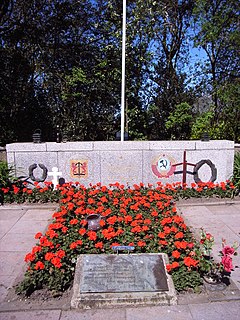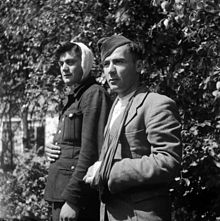Georgian uprising on Texel
| Uprising on Texel | |||||||
|---|---|---|---|---|---|---|---|
| Part of World War II, Western Front | |||||||
 Georgian military cemetery on Texel | |||||||
| |||||||
| Belligerents | |||||||
|
|
| ||||||
| Commanders and leaders | |||||||
|
|
| ||||||
| Casualties and losses | |||||||
|
565+ Georgians killed 120 Texel Dutch killed | 812 Germans killed | ||||||
The Georgian Uprising on Texel (Template:Lang-nl) (5 April 1945 – 20 May 1945) was an insurrection by the 882nd Infantry Battalion Königin Tamara (Queen Tamar or Tamara) of the Georgian Legion of the German Army (Wehrmacht Heer) stationed on the German occupied Dutch island of Texel (pronounced Tessel). The battalion was made up of 800 Georgians and 400 Germans, with mainly German officers. It was one of the last battles on the European theatre.[1][2]
Overview
The heavily fortified island was part of the German Atlantic Wall system of defense. However, after the Allied landings in Normandy it was relegated to relative insignificance. The men of the rebellious battalion were Red Army soldiers from the Georgian Soviet Socialist Republic captured on the Eastern front. They had been given a choice: the captured soldiers could choose either to remain in the prisoner of war camps, which would have meant abuse, starvation, and very possibly death, or to serve the Germans and be allowed a degree of freedom. The battalion was formed of men who chose the latter option.

The battalion had been formed at Kruszyna near Radom in occupied Poland in June 1943 and was used initially to fight partisans. On 24 August 1943 it was ordered to the West to relieve troops of the Indische Freiwilligen-Legion Regiment 950. The battalion arrived at Zandvoort in the Netherlands on 30 August. From September 1943 to early February 1945 it was stationed at Zandvoort as part of the "Unterabschnitt Zandvoort". On 6 February 1945 the battalion was posted to Subsection Texel. Preparations then started in late March 1945 for the transfer of several companies of the Georgian battalion to the Dutch mainland to oppose Allied advances, triggering the rebellion.[3]
Shortly after midnight on the night of 5–6 April 1945, the Georgians rose up and gained control of nearly the entire island. Approximately four hundred German soldiers were killed in the initial uprising, almost all while sleeping in the quarters they shared with Georgians, who used knives and bayonets. Others were shot and killed while standing guard or walking the roads of the island in groups or individually that night and the following day. Members of the Dutch resistance participated and assisted the Georgians,[4] however, the rebellion hinged on an expected Allied landing—which did not occur. The Georgians further failed to secure the naval batteries on the southern and northern coasts of the island; the crews of these artillery installations were the only Germans still alive on the island.
A counterattack was ordered and the intact artillery batteries on the island began firing at sites where rebels were suspected to be. Approximately 2,000 riflemen[5] of the 163rd Marine-Schützenregiment[6] were deployed from the Dutch mainland. Over the next five weeks they re-took the island; fighting was particularly heavy at Eierland and around the lighthouse.[7] The German troops then combed the length of the island for any remaining Georgian soldiers, while the Dutch inhabitants sought to hide them. The German commander of the 882nd battalion, Major Klaus Breitner, stated long after the war that the uprising was "treachery, nothing else"; the captured mutineers were ordered to dig their own graves, remove their German uniforms, and be executed.[5]
During the rebellion, 565 Georgians, at least 812 Germans, and 120 residents of Texel became casualties. The destruction was enormous; dozens of farms went up in flames, with damage later estimated at ten million guilders (US$3.77 million[8]). The bloodshed lasted beyond the German capitulation in the Netherlands and Denmark on 5 May 1945 and even beyond Germany's general surrender on 8 May 1945. The fighting continued until Canadian troops arrived 20 May 1945 to enforce the German surrender, and disarmed the remaining German troops.
Aftermath

The Georgians lie buried in a ceremonial cemetery at the Hogeberg near Oudeschild. The survivors may have feared facing the same fate as most Soviet collaborators: forced repatriation, under the terms of the Yalta Conference, often followed by incarceration and banishment and, for officers, execution. The 228 Georgians who survived by hiding from the German troops in coastal minefields, or who were concealed by Texel farmers, were turned over to Soviet authorities. After arrival at a collection camp in the Soviet Union, 26 Georgians were singled out and banished together with their families and nearly all others disappeared into Stalin's Gulags. Those still alive in the mid-1950s were rehabilitated and allowed to return home.[5] Until 1991, the ambassador of the Soviet Union to the Netherlands visited the graves of the Georgians on 4 May every year, and, at least during the latter visits, called the Georgians "Heroes of the Soviet Union". On 4 May 2005, Mikheil Saakashvili visited the graves for the first time as the president of independent Georgia.
The German dead were initially buried in a part of the general cemetery in Den Burg. In 1949 they found their final resting place at Ysselsteyn German war cemetery, Limburg province, the Netherlands. The cemetery is administered by the German War Graves Commission. Den Burg General Cemetery also contains a plot of 167 World War II Commonwealth burials, most of them airmen; 44 of the burials are unidentified.[9]
A permanent exhibition dedicated to these events can be found "in a corner" of the Aeronautical Museum[10] at Texel International Airport.[5]
One of the last Georgian survivors of the uprising died in July 2007 and was buried with military honors in Zugdidi, Georgia.[11] There were two Georgian survivors still alive in 2010: Grisha Baindurashvili, who is now 88 years old and lives in Kaspi, a village 40 km west of Tbilisi, and Eugeny Artemidze, who was one of the main organizers of the rebellion; he died at age 90 on June 22, 2010, on the same day that he went to war 69 years before.
Number of casualties
Canadian troops landed unopposed on Texel on 20 May 1945, effectively liberating the island. Over a two-day period the Canadians disarmed 1,535 Germans. Soviet SMERSH forces arrived on Texel and took charge of 228 Georgians still alive. A Canadian report prepared for the commander of the SMERSH contingent numbered 470 Georgian and 2,347 German casualties on Texel.[5]
In 1949, the German War Graves Commission disinterred on Texel 812 bodies (including the 400+ killed in their sleep by the Georgians in their shared quarters) for reburial at Ysselsteyn military cemetery.[12] The numbers given by the Texel district list "565 Georgians, 120 Texel islanders and approximately 800 Germans killed";[13] followed by "other sources ... speak of more than 2,000 Germans killed." The "other sources" comment in all probability refers to the Canadian report to SMERSH that lumped together under "casualties" the 1,535 disarmed Germans with their 812 dead.[5]
References
- ^ BBC "Coast" programme, 19 October 2012
- ^ Zaloga, Steven J (2011). The Atlantic Wall (2): Belgium, The Netherlands, Denmark and Norway. Osprey Publishing. p. 57. ISBN 1780961456.
- ^ Der Spiegel, 20/1995. "Der Geburtstag des Todes [The Birthday of Death]", p. 188
- ^ Der Spiegel, p. 189
- ^ a b c d e f Der Spiegel, p. 190
- ^ Composed of surplus naval personnel and organized as an infantry formation; all such ad hoc organizations of the same genre towards the end of the war were poorly equipped, had little or no infantry training, and suffered from low morale
- ^ View all contact details (1945-02-06). "The Georgian Uprising on Texel | VVV Texel". Texel.net. Retrieved 2016-10-29.
- ^ 1945/46 exchange rate per Bretton Woods system peg
- ^ "Cemetery Details". Cwgc.org. Retrieved 2016-10-29.
- ^ "Home". Lomt.nl. Retrieved 2016-10-29.
- ^ "Archived copy". Archived from the original on 2007-09-28. Retrieved 2007-07-18.
{{cite web}}: Unknown parameter|deadurl=ignored (|url-status=suggested) (help)CS1 maint: archived copy as title (link) - ^ The German War Graves Commission called the event Umbettung, roughly "exhumation and reburial"
- ^ "Archived copy". Archived from the original on 2009-09-24. Retrieved 2009-09-18.
{{cite web}}: Unknown parameter|deadurl=ignored (|url-status=suggested) (help)CS1 maint: archived copy as title (link)
Sources
- Dick van Reeuwijk. Opstand der Georgiërs, Sondermeldung Texel. Den Burg: Het Open Boek. Herzien Editie 2001, 71 pages. (The Georgian Rebellion on Texel). ISBN 9070202093
- Hans Houterman, J. N. Houterman, Eastern Troops in Zeeland, the Netherlands, 1943-1945, p. 62. Axis Europa Books, 1997. ISBN 1891227009
- Henri Antony Van der Zee (1998), The Hunger Winter: Occupied Holland, 1944-45, pp. 213–220. University of Nebraska Press, ISBN 0803296185 (Reprint. Originally published: London : J. Norman & Hobhouse, 1982.)
External links
- Conflicts in 1945
- Military history of the Netherlands during World War II
- Allied occupation of Europe
- Military history of Georgia (country)
- Texel
- Mutinies
- Uprisings during World War II
- 1945 in the Netherlands
- History of Soviet Georgia
- 1945 in Georgia (country)
- Battles and operations of World War II involving Germany
- Military history of the Soviet Union during World War II
- History of North Holland
- Military discipline and World War II
